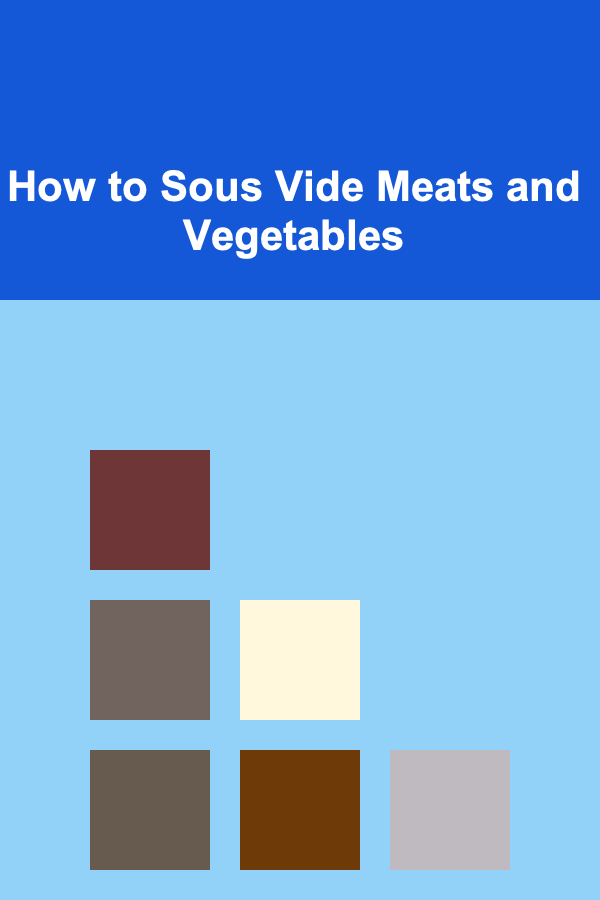
How to Sous Vide Meats and Vegetables
ebook include PDF & Audio bundle (Micro Guide)
$12.99$8.99
Limited Time Offer! Order within the next:

Sous vide, a French term meaning "under vacuum," is a cooking technique that involves sealing food in a bag and cooking it in a water bath at a precise, controlled temperature for an extended period of time. This method of cooking ensures that food is cooked evenly, retaining moisture, flavor, and nutrients. Though sous vide cooking has been around for decades, it has gained popularity in recent years, thanks to its ability to consistently produce restaurant-quality results.
In this guide, we will explore how to sous vide meats and vegetables, covering everything from the basics of sous vide to advanced techniques for different types of foods.
What is Sous Vide Cooking?
At its core, sous vide is a method that involves cooking food in a vacuum-sealed bag in water that is heated to a precise temperature. Unlike traditional methods like roasting, grilling, or frying, sous vide uses lower temperatures over a longer period, which allows the food to cook evenly from edge to edge. The low temperature ensures that the food doesn't overcook or dry out, resulting in tender, juicy, and flavorful meals.
How Does Sous Vide Work?
Sous vide cooking works through the use of precision and time. Traditional cooking methods rely on high heat, which can often cause the exterior of the food to cook faster than the interior. With sous vide, the water bath is set to a specific temperature, which allows the heat to evenly penetrate the food. The food is sealed in a bag to retain its juices and flavors, ensuring that it doesn't lose moisture during the cooking process.
The Benefits of Sous Vide Cooking
There are several reasons why sous vide has become increasingly popular among home cooks and professional chefs alike:
- Precision Cooking: Sous vide allows for the precise control of temperature, which means you can cook food to your desired doneness every time. Whether you prefer a steak rare, medium-rare, or well-done, sous vide ensures the perfect result.
- Consistency: Traditional cooking methods can be difficult to master, and even experienced cooks can struggle to achieve the same results consistently. With sous vide, once the food is cooked to the desired temperature, it will stay there without overcooking.
- Enhanced Flavor and Texture: Since food is sealed in a vacuum bag, it retains all of its natural juices and flavors. This method helps tenderize tougher cuts of meat and preserves the integrity of delicate vegetables.
- Convenience: Sous vide cooking requires little active attention. Once the food is in the water bath, you can leave it to cook for hours without worrying about it overcooking or drying out.
- Nutrient Retention: Because sous vide is a low-temperature cooking method, it helps retain more vitamins and minerals in your food compared to traditional cooking methods like boiling or frying.
Essential Equipment for Sous Vide Cooking
To get started with sous vide cooking, you will need a few essential pieces of equipment. Fortunately, the setup is relatively simple and doesn't require a lot of specialized tools.
1. Sous Vide Immersion Circulator
The immersion circulator is the most important piece of equipment for sous vide cooking. It is a device that heats the water to the desired temperature and circulates it to ensure even cooking. There are various models available, ranging from basic to advanced, with different features such as Wi-Fi control or Bluetooth connectivity for remote monitoring.
2. Vacuum Sealer and Bags
To keep the food submerged in the water bath and prevent it from floating, you will need a vacuum sealer. The vacuum sealer removes all the air from a bag, sealing the food inside and creating a tight seal to prevent water from entering the bag. There are also reusable silicone bags available for sous vide cooking, but vacuum-sealing is generally recommended for the best results.
3. Large Container or Pot
You'll need a container to hold the water bath. Many people use a large pot or a dedicated sous vide container. The size of the container depends on how much food you plan to cook, but it should be deep enough to fully submerge the food without overflowing.
4. Tongs and a Skillet (Optional)
After the sous vide cooking is done, you may want to finish the food with a quick sear in a hot skillet to develop a crispy exterior, especially for meats like steak or chicken. Tongs are helpful for handling the hot bags, and a good skillet is necessary for searing the food.
Sous Vide Meats
Sous vide is particularly popular for cooking meats, as it allows you to achieve a perfect, consistent result every time. Whether you're cooking a steak, chicken breast, pork tenderloin, or even tougher cuts like brisket, sous vide ensures the meat is cooked to perfection.
1. Beef
Beef is one of the most popular meats to cook sous vide, especially steaks. Sous vide allows you to achieve the ideal level of doneness without the risk of overcooking.
- Steaks: The temperature for steaks varies depending on how you prefer them. For a rare steak, cook it at 120°F (49°C) for 1-2 hours. For a medium-rare steak, set the temperature to 130°F (54°C), and for a well-done steak, aim for 160°F (71°C). After sous vide cooking, sear the steak in a hot skillet for 1-2 minutes on each side to develop a crispy, caramelized crust.
- Roasts: For larger cuts of beef, such as roast beef, sous vide can be used to cook it evenly throughout. A roast typically requires a longer cooking time than steaks---anywhere from 6 to 10 hours---depending on the thickness and the cut.
2. Pork
Pork is another versatile meat that benefits from sous vide cooking. Pork tenderloin, pork chops, and even pork belly all cook beautifully when prepared sous vide.
- Pork Tenderloin: Cook pork tenderloin at 140°F (60°C) for 1-2 hours. This results in a tender and juicy piece of meat that doesn't dry out. For a crispy crust, sear it quickly in a hot skillet after sous vide cooking.
- Pork Chops: For thick-cut pork chops, a sous vide bath at 140°F (60°C) for 1.5 to 4 hours will yield perfectly tender, moist meat. You can finish it with a quick sear to add color and flavor.
3. Chicken
Chicken breast is often dry and bland when cooked using traditional methods. However, with sous vide, you can achieve perfectly moist and tender chicken every time.
- Chicken Breasts: Cook boneless, skinless chicken breasts at 140°F (60°C) for 1 to 1.5 hours. This will result in a juicy, tender chicken breast that is full of flavor. If you prefer the skin on, cook the chicken with the skin and sear it in a pan afterward for extra crispiness.
- Whole Chicken: For a whole chicken, cook it at 150°F (66°C) for 4-6 hours to ensure that every part of the chicken is cooked through and tender.
4. Lamb
Lamb, with its rich and distinctive flavor, benefits greatly from sous vide cooking. The low and slow method allows the meat to remain tender without being too gamey.
- Lamb Chops: Sous vide lamb chops at 130°F (54°C) for 1.5 to 2 hours for a medium-rare result. For lamb shanks, cook them at 170°F (77°C) for 8 to 12 hours for a fall-apart-tender texture.
Sous Vide Vegetables
Sous vide isn't just for meats---it's also a fantastic way to cook vegetables. Since sous vide retains the natural flavor and nutrients of the vegetables, it is ideal for cooking delicate items like asparagus, carrots, and zucchini, as well as heartier vegetables like potatoes and squash.
1. Potatoes
Potatoes are incredibly versatile and can be cooked sous vide to perfection. For mashed potatoes, cook them at 190°F (88°C) for 1 to 2 hours. For roasted potatoes, cook them at 185°F (85°C) for 1 to 1.5 hours, then toss them in oil and seasonings and finish them in a hot oven or skillet for a crispy exterior.
2. Carrots
Sous vide carrots turn out tender and sweet, retaining their natural flavor. Cook them at 183°F (84°C) for 1-2 hours. You can add butter and seasonings directly into the bag to infuse the carrots with extra flavor during the cooking process.
3. Asparagus
Asparagus is delicate and can easily become overcooked. Cooking it sous vide at 185°F (85°C) for 10-15 minutes ensures it remains tender-crisp while retaining its vibrant green color.
4. Zucchini
Zucchini tends to become mushy when overcooked, but sous vide ensures that it stays firm and retains its flavor. Cook it at 185°F (85°C) for 30-45 minutes.
5. Corn on the Cob
To cook corn on the cob, vacuum-seal the corn with a bit of butter, salt, and pepper, and cook it at 185°F (85°C) for 1-2 hours. The result is tender, juicy corn that tastes as though it's been roasted.
Tips for Success in Sous Vide Cooking
- Don't Overcrowd the Water Bath: Ensure that the water can circulate freely around the food for even cooking. If you're cooking multiple items, make sure they are not stacked too tightly together in the bag.
- Experiment with Flavors: Sous vide allows for unique flavor combinations, so don't hesitate to add herbs, spices, and seasonings to the vacuum-sealed bag. Infusing flavors during the cooking process creates an elevated dining experience.
- Safety First: Be mindful of food safety. Always cook meats to the recommended temperatures, and ensure your immersion circulator maintains a consistent temperature throughout the entire cooking process.
- Finish with a Sear: For meats, searing them after sous vide cooking adds texture and flavor. Use high heat and a small amount of oil to get a perfect crust without overcooking the food.
Conclusion
Sous vide cooking offers a precise and foolproof method to cook meats and vegetables to perfection. The ability to control temperature down to the degree ensures that you can achieve your desired level of doneness every time, whether you're preparing a tender steak, juicy chicken, or flavorful vegetables. With the right equipment and techniques, anyone can master the art of sous vide cooking and enjoy restaurant-quality meals in the comfort of their own home.

How to Create a Stylish Entryway with Minimal Decor
Read More
How to Organize a Family Holiday-Themed Craft Party
Read More
How to Renovate Your Home for Better Organization and Flow
Read More
How to Understand Bird Anatomy for Identification
Read More
How To Practice Unit Testing for Robust Code
Read More
How to Use Typography Effectively on Wine Bottle Labels
Read MoreOther Products

How to Create a Stylish Entryway with Minimal Decor
Read More
How to Organize a Family Holiday-Themed Craft Party
Read More
How to Renovate Your Home for Better Organization and Flow
Read More
How to Understand Bird Anatomy for Identification
Read More
How To Practice Unit Testing for Robust Code
Read More